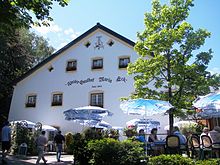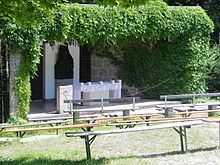Maria Eck monastery
The Maria Eck monastery is a monastery of the Franciscan Minorites in the municipality of Siegsdorf in Bavaria in the archdiocese of Munich and Freising .
history
The local priory of the Benedictine monks of Seeon Abbey was founded in the 17th century and dissolved in the course of secularization . Franciscan Minorites have lived in the monastery on the "Egger Berg" since 1891 . The postulate and novitiate (the first stages of formation) of the order are located in Maria Eck .
Former Pope Benedict XVI. has a special relationship with Maria Eck. Geographically, the pilgrimage monastery is in close proximity to the so-called Benediktweg , a pilgrimage route along the former places of activity of the Pope. During his time in Traunstein, as well as later as Cardinal Ratzinger, Pope Maria Eck paid frequent visits. According to press reports, the team at the Maria Ecker Klostergasthof around Br. Erich Raspel, the head of the Catholic Church, cooked food during his pastoral trip through Bavaria (stay in Munich).
Pilgrimage
The pilgrimage to Maria Eck dates back to the 16th century. During the Thirty Years' War , the number of pilgrims kept increasing. Today the pilgrimage to Maria Eck is one of the largest pilgrimages in the Archdiocese of Munich-Freising. Are known z. B. the annual costume pilgrimage of Gauverband I and the pilgrimage of the disabled from the Chiemgau . Accordingly, a larger inn belongs to the monastery .
Pilgrimage church
The foundation of the pilgrimage church Maria Eck goes back to an old legend. Lumberjacks are said to have seen light appearances time and again in this area. When they built a wooden chapel, two lights are said to have appeared. In this they saw a divine reference to the erection of two more altars in honor of the Holy Trinity.
The first small chapel in the area of today's church was built in 1618–35, when the Seeon monastery bought some alpine houses and built a chapel. Already at this time the first pilgrimage to Maria Eck developed under the framework of the Thirty Years War . A larger church was built on the site of this first chapel in 1636.
In 1803, the Maria Eck pilgrimage church was dissolved as part of secularization . The pastor from Siegsdorf was one of the biggest drivers behind this action. As part of the closure, much of the church's furnishings were either sold or destroyed.
In 1806 the church was then to be destroyed. A demolition team was already on its way to Maria Eck, including the pastor of Siegsdorf. However, the local farmers had banded together and stormed the demolition team. The demolition squad then fled. Only the pastor and the official messenger were provided by the peasant horde and had to take a beating as a result.
In 1810, the Maria Eck pilgrimage church and the surrounding property are auctioned off to private individuals. However, this auction will be canceled one month later.
The church came into the public eye once again during the Nazi regime in 1936. A Gauleiter had the church key handed over and ordered it to be closed. In addition, two of the four bells were removed and melted down to make weapons.
Fossilized nummulites can be found in the area, which are also known as Maria-Ecker-Pfennige due to their coin-like shape. According to a local legend, Our Lady turned the booty of a thief who had plundered the offering box into stone while he was fleeing.
literature
- Gotthard Kießling, Dorit Reimann: District of Traunstein (= Bavarian State Office for Monument Preservation [Hrsg.]: Monuments in Bavaria . Volume I.22 ). Kunstverlag Josef Fink, Lindenberg im Allgäu 2007, ISBN 978-3-89870-364-2 .
Web links
Individual evidence
- ↑ a b The Maria Eck pilgrimage church. In: Chiemgau-Blätter of the Traunsteiner Tagblatt.
- ↑ Dr. Schafhäutl: Contributions to a closer knowledge of the Bavarian Prealps , scholars display the k. bayer. Academy of Science; No. 89, May 5, 1846 - Bavarian State Library digital - Scholarly advertisements ; Volume 22, 1846; Page 717; Scan 365
Coordinates: 47 ° 47 ′ 35.8 ″ N , 12 ° 37 ′ 7.5 ″ E



